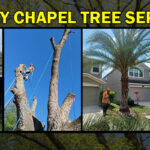Why remove a tree stump, and how it is done.
As an arborist, one of the most common tasks we encounter is tree stump removal. While it may seem like a simple task, there are many important considerations that must be taken into account to ensure that the job is done safely and effectively. In this blog post, we will discuss the proper techniques for tree stump removal from an arborist’s point of view.
Why Remove a Tree Stump?
There are several reasons why it is important to remove a tree stump, including:
- Aesthetics: A tree stump can be an eyesore in an otherwise beautiful landscape.
- Safety: A tree stump can pose a tripping hazard, especially for children and elderly individuals.
- Disease prevention: A decaying stump can attract pests and diseases that can harm other plants in the area.
- Space utilization: Removing a tree stump can free up space for other landscaping or construction projects.
Proper Techniques for Tree Stump Removal
- Assess the situation: Before beginning any stump removal job, it is important to assess the situation to determine the size and depth of the stump, as well as any obstacles or hazards in the area. This will help you determine the best approach for removing the stump.
- Use the right tools: Depending on the size of the stump, you may need to use a variety of tools to remove it, including a chainsaw, a stump grinder, a shovel, and a pry bar. It is important to use the right tools for the job to ensure that the stump is removed safely and efficiently.
- Cut the stump down to ground level: Using a chainsaw, cut the stump down to ground level. This will make it easier to remove the stump and will also reduce the risk of tripping hazards.
- Use a stump grinder: A stump grinder is a powerful tool that is used to grind the stump down to below ground level. This will not only remove the stump but also the root system, which will prevent any new growth from occurring.
- Fill in the hole: Once the stump and roots have been removed, fill in the hole with topsoil and compact it down. This will ensure that the area is level and safe.
- Dispose of the debris: Depending on the size of the stump and the amount of debris generated during the removal process, you may need to dispose of the debris in a landfill or other waste disposal site. Be sure to check with your local municipality to determine the proper disposal method.
Conclusion
Removing a tree stump may seem like a simple task, but it requires careful planning and execution to ensure that the job is done safely and effectively. By following these proper techniques for tree stump removal, you can ensure that the area is safe, free from hazards, and ready for future landscaping or construction projects. If you are unsure about how to remove a tree stump or have any questions about tree care, be sure to consult with a certified arborist who can provide expert advice and guidance.
Contact Advanced Arborist today for a free estimate from a Certified Arborist!




